Verde Guatemala Marble originates from the mineral-rich Aravali mountain range in Rajasthan, India—specifically from quarries near Udaipur (Kesariyaji/Rishabhdeo region) and Bidasar (Churu district). These deposits were discovered in the late 1970s and early 1980s, with nearly 300 quarry leases currently operating across vast hilly and mountainous terrain in southern Rajasthan. The region’s geological processes have contributed to the stone’s unique coloration, veining patterns, and visual appeal that make it internationally sought-after.
Despite its commercial name suggesting Central American origin, Verde Guatemala is exclusively (or predominantly) quarried in India, with only minimal extraction historically occurring in Guatemala and Brazil. The “Verde” designation comes from Spanish and Italian languages where it means “green,” reflecting the stone’s primary characteristic. The marble gained its Guatemala association through early international trade naming conventions rather than geographical origin.
Geologically, Verde Guatemala is classified as serpentinite- a metamorphic rock formed through serpentinization of peridotite, where most mineral components transform into phyllosilicate compounds. The strong presence of serpentine mineral groups creates the characteristic emerald to dark green coloration. Under European Standard applications, this stone must be properly designated as serpentinite rather than marble in technical documentation, though it is internationally marketed as marble for commercial purposes.
The stone exhibits considerable natural variation in shade and veining pattern. Udaipur quarries produce varieties ranging from Dark Green and Light Green (Jade) to Forest Green, Empress Green, and Emerald Green. Bidasar quarries yield the exotic Rainforest Green Marble, also called Bidasar Green. The verde can vary from light to dark green with white veining that contrasts the power of the green background, while some varieties display yellow or light green web-like patterns resembling spider webs. Mineral crystals within the stone create natural shine that enhances when polished.
Buyers specify Verde Guatemala for luxury residential interiors seeking timeless elegance, commercial lobby flooring where durability meets aesthetics, feature walls in hospitality environments including hotels and restaurants, kitchen countertops and backsplashes adding natural charm, bathroom vanities and shower walls, outdoor landscaping features when properly sealed, stair treads and risers, pool capping and fountain construction, window sills, monuments and sculptures, and decorative mosaics showcasing intricate patterns. The refreshing green shades and unique veining patterns coordinate with both contemporary minimalist and traditional ornate design styles.
Alternative names: Forest Green Marble, Guatemala Verde Marble, Indian Green Marble, Udaipur Green Marble, Rajasthan Green Marble, and Vert Guatemala.
Performance and Quality
Verde Guatemala demonstrates performance characteristics suitable for diverse demanding applications. The water absorption rate of 0.19-0.48% by weight falls within acceptable marble ranges, providing good moisture resistance when properly sealed. Density of 2,660-2,700 kg/m³ indicates solid structural integrity appropriate for both horizontal and vertical installations.
The stone is described as highly dense, durable, and weather-resistant for both interior and exterior applications. Indian green marble is notably very compact and mature with strength and hardness greater compared to other green stones found globally. However, buyers must understand that marble—including serpentinite marketed as marble—is softer than granite and more susceptible to scratching, etching from acids, and staining without proper protection.
Heat resistance is moderate; the stone withstands normal household temperatures but can be damaged by extreme heat or thermal shock. Always employ trivets or hot pads for cookware to prevent damage. Sharp or abrasive objects can leave scratches on the surface that require professional restoration. Users must use cutting boards for food preparation to preserve countertop integrity.
The stone requires regular sealing to prevent staining and maintain optimal appearance. Marble is prone to etching and discoloration by acids in the absence of protective sealer coating. Without proper sealing maintenance and prompt spill cleanup, permanent staining can occur from wine, coffee, citrus juices, oils, and pigmented liquids. The deep green color shows stains less prominently than white marbles, providing practical advantage for busy households.
Expected service life ranges from 15 to 40+ years for interior applications with diligent maintenance. The stone’s durability when properly maintained makes it suitable for high-traffic residential and moderate commercial spaces. Outdoor installations require more intensive care including more frequent sealing and may show weathering over time depending on climate conditions.
Materials and Construction
Verde Guatemala undergoes specialized processing due to its geological composition. Modern mechanized quarrying employs chain saws, wire saws, boring machines, and heavy earth-moving equipment for efficient extraction. The technology advancement has significantly increased production capacity—estimated at approximately 150,000 metric tons in 2011 with continued growth through 2025.
Blocks extracted from quarries are large, enabling production of big-size slabs without limitations—a significant advantage for creating seamless installations in large spaces. After quarrying, blocks transport to processing facilities equipped with state-of-the-art machinery including gang saws, automatic line polishers for slabs, bridge cutting machines, fully automated tiling plants, and automatic epoxy lines. Rajasthan hosts approximately 150 modern gangsaw units with sophisticated processing capabilities.
The darker versions of Verde Guatemala sometimes exhibit natural cracks and are thus predominantly commercialized as tiles rather than large slabs. For darker materials processed into slabs, manufacturers may apply resin treatment to fill natural fissures and micro-cracks before polishing—standard industry practice ensuring structural stability and smooth surface finish.
The polishing process progresses through multiple grinding and buffing stages using progressively finer abrasives. The most common finish is polished, though honed finish also maintains steady demand. The high polish achievable on this material clarifies coloring, brightens veining, and creates light-reflective luxury appearance. Polished surfaces also provide practical cleaning advantages compared to textured finishes.
| Property | Value | Standard Test Method |
| Water Absorption | 0.18 % | ASTM C97 |
| Density | 2,720 kg/m³ | ASTM C97 |
| Compressive Strength | 108 MPa | ASTM C170 |
| Flexural Strength | 16.8 MPa | ASTM C880 |
| Abrasion Resistance | 18.5 mm | ASTM C241 |
Maintenance and Care
Verde Guatemala Marble requires attentive maintenance to preserve appearance and longevity. Prevention is the key—always wipe spills and splashes immediately, particularly acidic substances. Daily cleaning requires only mild, pH-neutral dish detergent diluted in warm water (1 teaspoon per liter), applied with soft microfiber cloth. Never use harsh cleaners, vinegar, ammonium-based detergents, acidic cleaners, bleach, or abrasive scrubbing products that scratch surfaces or remove sealer.
Apply quality impregnating sealer at minimum once annually; high-use areas like kitchen countertops benefit from annual resealing without exception. Test sealer effectiveness by placing water droplets on the surface—if absorption occurs within 10 minutes rather than beading, immediate resealing is necessary. For persistent stains, use marble-specific detergent following manufacturer instructions.
Always use cutting boards and potholders on marble surfaces. Even with diligent cleaning, marble might stain and color may change over time—this is characteristic of natural stone and should be anticipated. For outdoor installations, establish quarterly cleaning schedule and biannual sealing to protect against weather exposure and maintain weatherproof properties.
For flooring, establish routine of daily dust mopping to remove grit that can scratch when walked upon. Weekly damp mopping with neutral cleaner maintains appearance. Place walk-off mats at entrances to trap dirt and moisture. High-traffic commercial flooring benefits from professional deep cleaning annually.
Expected maintenance costs include annual sealer (approximately $30-50 per bottle covering 100-150 sq ft), professional cleaning services ($150-300 annually for residential installations), and potential restoration services ($5-15 per sq ft) if etching or deep staining occurs despite preventive care.
Installation and Compatibility
Professional installation by experienced stone fabricators familiar with marble is essential. Verde Guatemala installation requires specialized skills due to the material’s characteristics and weight. For countertop applications, fabricators create precise templates, cut slabs using diamond-blade wet saws, polish edges to desired profile, and install using marble-compatible adhesives. Installation typically requires 2-4 days for standard residential kitchen configurations.
For flooring and wall cladding, use white, polymer-modified thinset mortar specifically designed for marble tile installation. High-quality products include Laticrete Marble & Granite Mortar, Mapei Ultraflex LFT, and Schluter Kerdi-Fix—all offering excellent bonding strength, waterproof properties, and non-slip characteristics. Follow manufacturer instructions precisely for proper usage and application.
Substrate preparation is critical. Ensure substrate is level, stable, and appropriate for the stone’s weight (approximately 13-14 lbs per square foot for 2cm thickness; 19-21 lbs for 3cm). Floor deflection must not exceed industry standards, as excessive flex can crack marble. For wall installations, proper waterproofing membrane installation behind stone is essential in wet areas.
Grout selection significantly affects final appearance and maintenance. Unsanded grout prevents scratching polished edges during grouting. Light grey or soft white grout harmonizes with lighter veining for seamless elegant appearance. Contrasting darker grout emphasizes individual tiles but may show dirt more readily. Epoxy grout provides superior stain resistance for kitchen applications and commercial food-service areas.
For outdoor applications including pool capping, fountains, and landscaping features, apply marine-grade penetrating sealer before installation and establish rigorous maintenance schedule. Cover outdoor surfaces during harsh weather when possible to protect sealer and minimize weathering effects.
Pros & Cons
Advantages
- Distinctive natural beauty: Rich green hues with intricate veining create luxurious, exotic appearance impossible to replicate with synthetic materials
- Excellent durability: Highly dense, compact stone with strength greater than other green marbles; suitable for high-traffic residential and moderate commercial use
- Versatile design compatibility: Refreshing green shades coordinate with contemporary, traditional, and eclectic styles; adds natural charm to any project
- Cost-effective premium stone: More affordable than granite while offering comparable performance and superior polishing characteristics; excellent value proposition
Considerations
- Requires regular maintenance: Annual sealing mandatory; immediate spill cleanup essential; more maintenance than granite or engineered quartz
- Acid sensitivity: Susceptible to etching from citrus, vinegar, wine, and acidic cleaners; cutting boards and trivets non-negotiable
- Higher cost than standard marble: Premium/luxury classification commands pricing above common beige or white marbles; not budget-friendly option
Who Should Buy
Ideal Buyers
- Luxury residential renovators seeking distinctive natural stone with proven durability and timeless elegance for premium kitchen and bathroom projects
- Commercial developers requiring visually striking yet cost-effective flooring for hotel lobbies, restaurant interiors, or corporate reception areas
- Green design enthusiasts drawn to natural green tones who commit to proper maintenance protocols and appreciate unique natural variation
- Hospitality architects specifying feature walls, bar tops, or decorative elements where exotic aesthetic creates memorable guest experiences
- International buyers in Middle East markets (Turkey, Egypt, Saudi Arabia, UAE) where Verde Guatemala maintains strong popularity and design preference
Not Recommended For
- Budget-conscious projects where cost is primary concern over aesthetics (consider standard ceramic or porcelain tiles instead)
- Busy households unwilling to maintain annual sealing schedule or clean spills immediately
- Ultra-high-traffic commercial flooring like shopping mall corridors (consider granite or engineered stone)
- EU projects where specifiers cannot accommodate serpentinite classification in technical documentation
- Buyers expecting maintenance-free surfaces or those accustomed only to granite’s superior scratch resistance
FAQs
Q1: Why is Verde Guatemala called “Guatemala” marble if it comes from India?
Despite the name suggesting Central American origin, Verde Guatemala is predominantly quarried in Rajasthan, India (Udaipur and Bidasar regions). Only minimal extraction historically occurred in Guatemala and Brazil. The commercial name derives from early international trade naming conventions rather than primary geographical origin. “Verde” means green in Spanish and Italian. The stone is also accurately called India Green Marble, Udaipur Green, or Rajasthan Green.
Q2: What is the difference between serpentinite and marble, and does it affect Verde Guatemala’s performance?
Serpentinite is a metamorphic rock formed through serpentinization of ultramafic rocks, while marble forms from metamorphosed limestone. Verde Guatemala is geologically serpentinite but marketed as marble internationally. Performance characteristics are comparable to true marbles. However, European Standards (EN 12440) require proper serpentinite designation in EU project specifications for regulatory compliance. This does not indicate inferior performance.
Q3: Can Verde Guatemala Marble be used for outdoor applications in cold climates?
Yes, when properly sealed and maintained. Verde Guatemala is described as weather-resistant and suitable for exterior applications including pool capping and fountains. However, establish biannual sealing schedule for outdoor installations and quarterly cleaning. In freeze-thaw climates, cover surfaces during harsh winter weather when possible to protect sealer and minimize thermal cycling effects. Expected outdoor lifespan is 10-25 years depending on climate and maintenance.
Q4: How does Verde Guatemala compare in cost to other green marbles from India?
Verde Guatemala is cost-effective compared to Indian granite while offering premium aesthetics. Within Indian green marbles, pricing varies by specific variety: Forest Green (₹80-140/sq ft) is most affordable, Verde Guatemala/Dark Green (₹120-180/sq ft) is mid-range, and Rainforest Green from Bidasar (₹150-240/sq ft) commands premium pricing due to limited availability and exotic patterns. All are significantly more affordable than imported European green marbles.
Q5: What makes darker versions of Verde Guatemala more prone to cracking?
Darker versions naturally tend to have more cracks due to the specific mineral composition and metamorphic processes that create deeper green coloration. These darker materials are thus mostly commercialized as tiles rather than large slabs. When processed into slabs, resin treatment fills natural fissures to ensure structural stability. This is standard industry practice and does not indicate quality deficiency—it reflects the stone’s natural geological characteristics.
Q6: How often should Verde Guatemala Marble be resealed, and what happens if I skip sealing?
Reseal minimum once annually for standard residential use; high-use kitchen countertops benefit from annual resealing without exception. Without proper sealing, marble is prone to etching and discoloration from acids, permanent staining from oils and pigmented liquids, and moisture penetration that can cause structural issues over time. Test sealer effectiveness annually by placing water droplets—if absorption occurs within 10 minutes, reseal immediately.

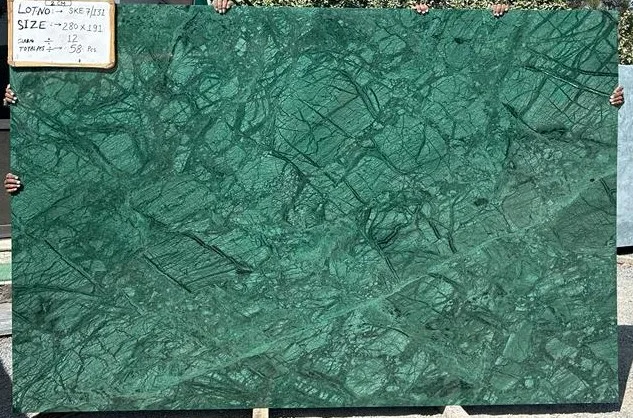
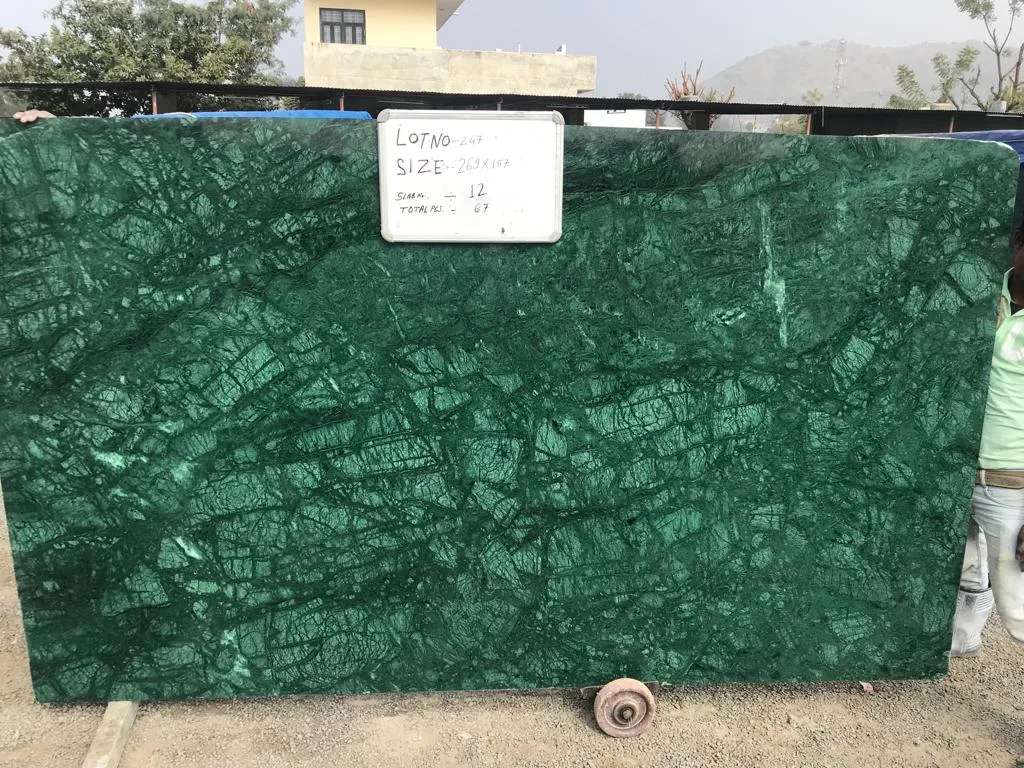
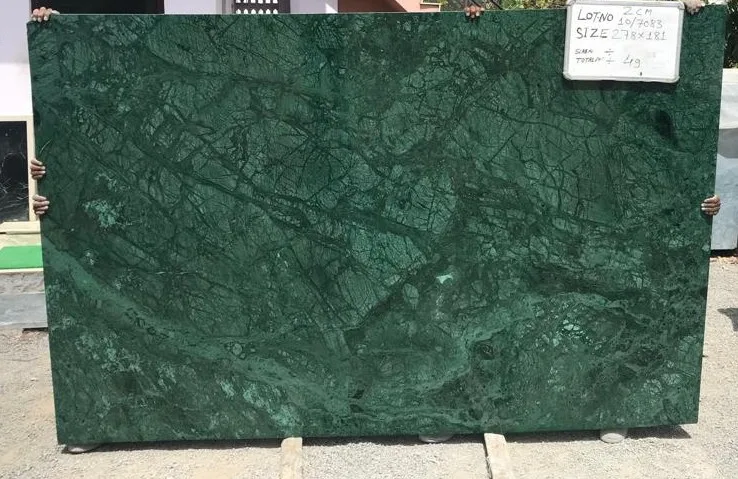
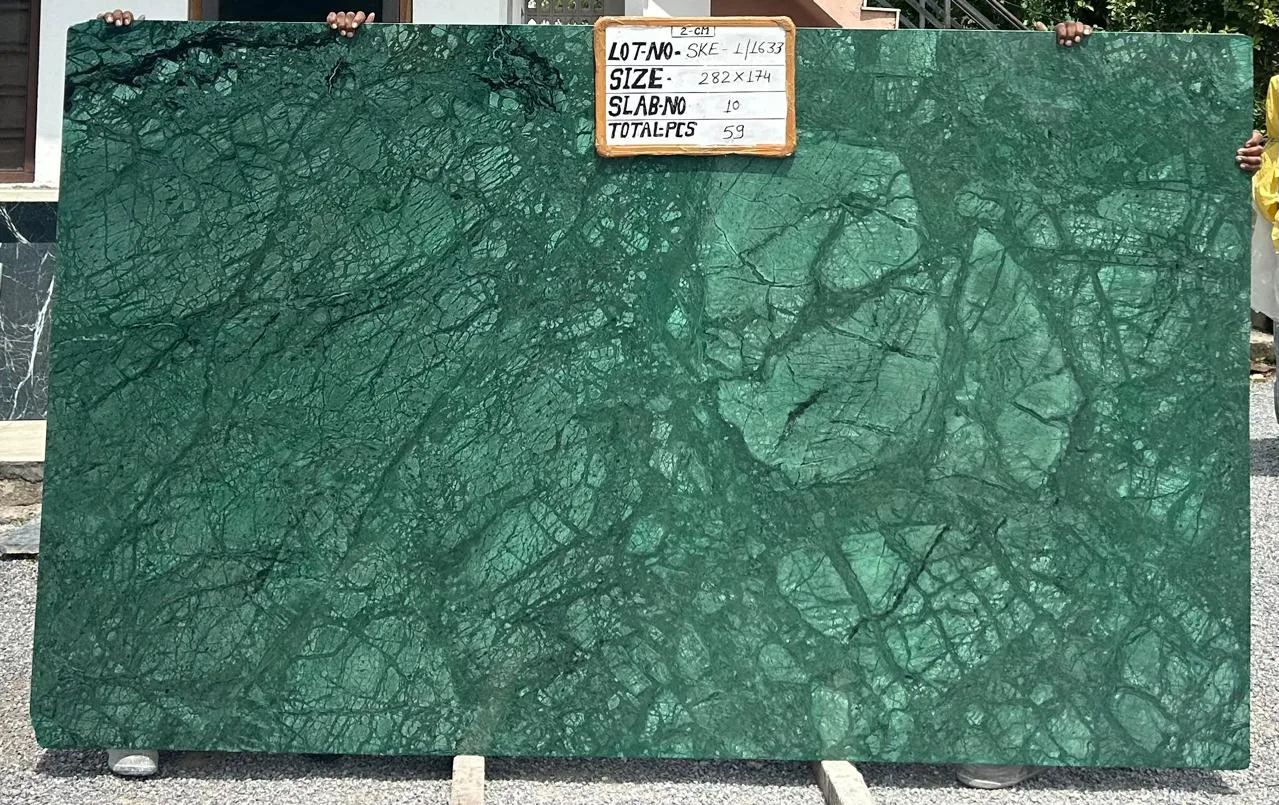
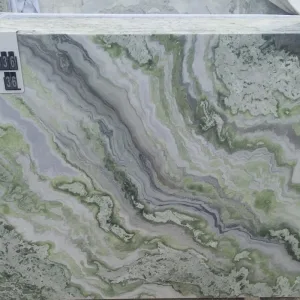

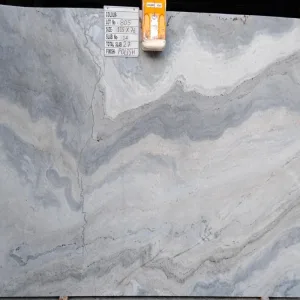
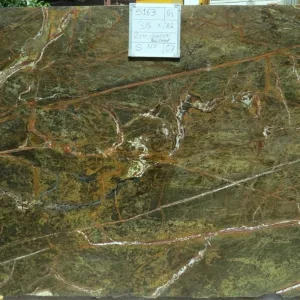
Reviews
There are no reviews yet.